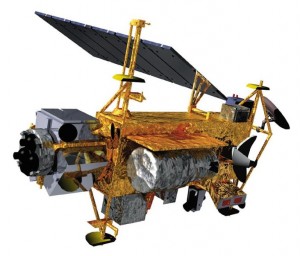Update (17 September 2011): Since I made my last post about the re-entry of NASA’s Upper Atmosphere Research Satellite (UARS), it’s orbit has decreased even further. In the last approximately 36 hours NASA has changed the re-entry forecast twice. Unfortunately the rapid change in its orbit means that visibility predictions for this satellite are now unreliable. We now have to wait for NASA to issue a reasonably accurate re-entry forecast. This won’t happen until 12 hours before the decay time. At the time of writing this, re-entry is expected to be around 23 September 2011.
(Original post) Despite the failure of the launch of its latest resupply spacecraft (the Progress 44 mission whose third stage failed resulting in the freighter plunging to its doom over the Altai Republic in southern Siberia), the International Space Station continues to successfully orbit the Earth. The same can’t be said for NASA’s Upper Atmosphere Research Satellite (UARS) satellite. The 5,900 kg satellite was deployed in 1991 from Space Shuttle Discovery mission STS-48 on a mission to study the Earth’s atmosphere (with a focus on the Earth’s ozone layer). UARS was turned off in December 2005 and has slowly being falling towards the Earth ever since (slowed by atmospheric drag). Crunch time is expected to occur sometime between 29 September and 4 October 2011.

Why mention the International Space Station and UARS in the same blog post? Well, aside from the fact that the International Space Station had to be moved in its orbit to avoid a potential collision with UARS on October 26 2010, both objects will be visible in our evening sky over the next few nights. The exact times will vary for your location. Go here on this site for instructions on how to find visiblilty times for your location (using the Heavens-above website). Note that you will need to do a search for the UARS satellite by following the ‘Select another satellite from the database’ link once you are at the Heavens-Above website page for your location. Keep in mind that both satellites will look like bright slowly moving stars to the unaided eye.
So get out and look for UARS over the next couple of nights before it plunges to Earth and its destruction. NASA is planning to confirm the exact time shortly before it is due to occur. Oh, and if it does de-orbit overhead, look out. There is a very small chance that a tiny bit may land on your head!